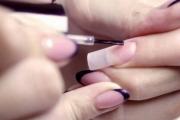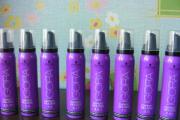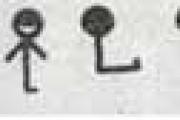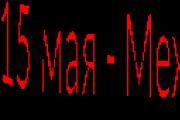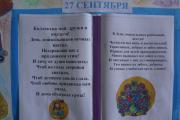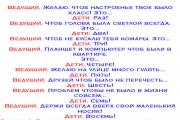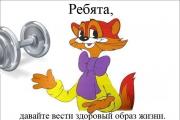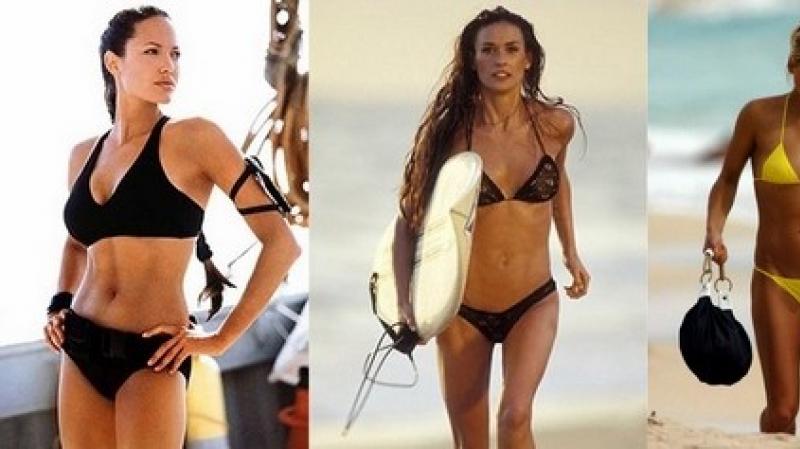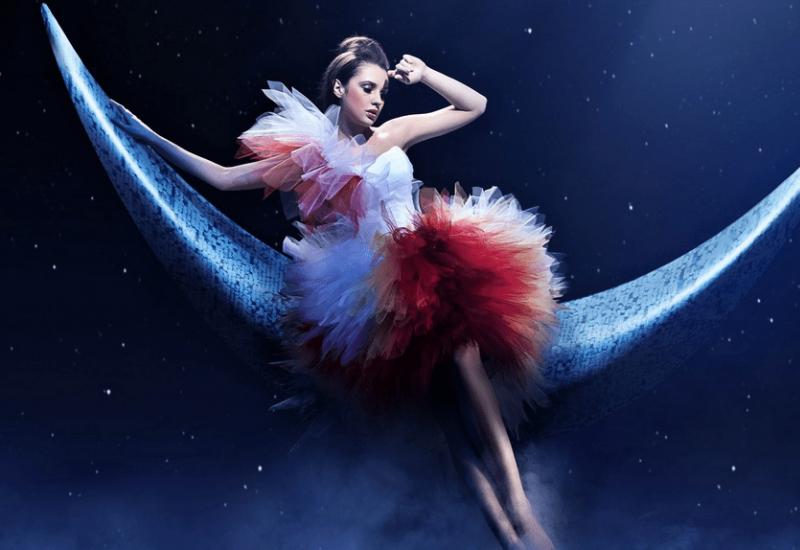We knit for dogs of small breeds according to the schemes with a description. Rules for knitting clothes with knitting needles for dogs of small breeds How to knit a dress for a dog with knitting needles
jumpsuit with hood
Clothes for dogs! part 2
OVERALL WITH HOOD
Have you made sure that do-it-yourself dog clothes are not so difficult? Well, we are moving along the path of complication of models, and from a simple sweater we slowly reached a jumpsuit with a hood. Now I will write for you as for people who know and can do a lot.
So where do we start? Of course, with the purchase of threads. For those who already have mohair in their livers after the “chameleon”, I suggest buying a woolen or semi-woolen thread. For additional decoration of models, you can take the thread "grass". For wool and semi-wool, we need thicker knitting needles, somewhere around 3.5-5.
taking measurements.
First measurement- the length of the overalls. You know how to take this measurement: you need to put a collar on the dog so that it is loose on it, and measure the length of the back from the collar to the root of the tail.
Second measurement- volume of the neck. You can measure by unfolding and measuring the collar that you usually put on your dog.
Third measurement- chest size. Measured behind the elbows.
Fourth measure- the length of the hood. The distance from the occiput to the withers is measured. You can add 1-2 cm in order to be freer and more beautiful.
As always, first we knit a sample of 22 loops and see how many centimeters the canvas turned out. We calculate by the second measure how many loops you need to dial. I took orange “grass” for one of the options, I got 46 loops plus two edge loops, i.e. 48 loops.

We knit these 48 loops according to the fourth measurement, so that we get a rectangle. Happened? So the hood is almost ready.
Now we make holes for the ribbon. You already know this, of course, but I'll repeat it anyway. We need to get an even number of holes, so we divide our 46 loops (I don’t take into account the edge ones) by the number of holes (8 pieces) and we get six loops. Now we will knit two loops from the edge and make a crochet, then knit two loops together. So, it turns out: yarn over, two loops together, four according to the yarn pattern, two together, four according to the pattern. And so on to the end of the row. In order for the holes to become holes, you need to knit the next row according to the pattern, and to make the result more pronounced, knit two more rows before you start dividing the fabric and adding loops to form the body.
There are holes, but we need to make wedges on both sides so that the jumpsuit sits on the dog most comfortably. We knit the wedges from the edge, as it suits you. I knitted 14 loops, returned to the edge, then 8 loops - returned to the edge, then 17 loops, returned to the edge, and knitted a full row. On the other hand, I repeated everything. Wedges are ready!
Here we come to the third dimension. Using simple calculations, you will determine how many centimeters your dog's chest is larger than his neck. A couple more finger poke into the calculator - and you will find out how many loops you need to add to get the desired width of the fabric.
Since our jumpsuit is with a hood, we will fasten it not on the back, but on the dog's chest. therefore, we will need to divide the canvas into three parts, but not the same as in the "chameleon". First of all, we will form the chest strips, on which there will be a fastener. Before knitting, decide what type of fastener you will use: buttons, Velcro or plastic buttons on a knitted tape.

Buttons have a lot of advantages: they are comfortable, familiar, they are quite easy to fasten, you can match the color of any thread, and if the buttons are beautiful and contrast with the color of the thread, they can decorate the product.
Velcro is also quite convenient, especially if the thread is not shaggy. But there is one drawback: it is thick, and the canvas will puff up on a small jumpsuit. However, if you are not a fan of fastening a bunch of buttons, it is better to take Velcro

knitted tape with plastic buttons. It appeared on the market not so long ago, an almost ideal fastener for our doll overalls!
And what's the difference, will the jumpsuit be fastened with buttons or with buttons? Yes it's big! If on the buttons, then the fabrics will be buttoned end-to-end, and if the buttons, then they will overlap, which means that for the strips it will be necessary to knit a different number of loops: 5 + 2 is enough for the buttons, and for the buttons we select the same five loops for each strip, but in the first in the same row we add three or four loops to create a wider strip. As usual, we knit strips to the elbow, and tear off the thread, dropping the loops on a knitting pin.
While we knitted strips for the chest, the loops for the main fabric were on a pin. It's time to take care of them. We remove the loops on the knitting needle and begin to knit the first row, adding the number of loops that we calculated earlier. Naturally, we knit a row after the addition in order to “legitimize” the addition of loops and form a pattern. By the way, because the canvas on the back will be monolithic, you can show your imagination and knit some simple pattern, for example, a pair of braids. It will look very nice!
And now let's get back to our favorite (or unloved?) wedges. It is necessary to make them so that the canvas does not bulge on the back. After we have knitted a row that has added loops, we knit a wedge first from one, then from the other edge. So: 14 loops - return to the edge - 8 loops - return to the edge - 16 loops - return to the edge - we knit the row to the end. Everything, the first wedge is ready! We knit the second wedge in the same way.

New Secrets!!!

If you are knitting a jumpsuit for a girl, you can knit a longer fabric, almost to the hips, and only then cast off 6-7 loops on each side to form a fastener. In the next 5-6 rows, one edge loop should be cut from the edges to form the final canvas that covers the back.

but if for a boy, I advise you, after knitting 4-5 rows, cut 4 loops on each side, i.e. knit 1-2, 3-4, 5-6 and 7-8 in pairs, with the next row cut 2 more loops, i.e. 1-2 and 3-4, then cast off 6-7 sts on each side. Then knit and decrease the loops in the same way as on the “female” version.
Why is it so early to start closing loops for males? But you are knitting for a boy! You don’t want your overalls to be wet from the side of your stomach after the first walk ...
Knit the back according to the first measurement. The best way to control the length of the jumpsuit is to measure from time to time the distance from the holes you made for the lace to the knitting needle.
how to finish the back
After all, we want nothing to bulge, so for the last two rows before closing the loops, you need to cut a pretty decent number of loops! I recommend knitting together every sixth stitch on the first row of cuts, and every eighth stitch on the second row of cuts. Now crochet tightly close the loops. You have received a dense edge that will not bulge, but will gently adhere to the back.

Now you need to make a hood from a piece of fabric from which knitting began. To do this, fold it in half and sew.

In order for the edge of the hood and clasp to be more durable and not stretch, crochet it.
secret number one

if you are making a jumpsuit with buttons, when tying one of the edges, make 4-5 air loops every three loops. They will become buttonholes.
secret number two

it is better to knit the edge of the hood with a double crochet. After tying, sew the rubber band through the rows that you got when crocheting.
secret number three
In order to prevent the hood from flying off the dog's head, before picking up the hook, put the jumpsuit on the dog, put the hood on her head and mark the place under the chin. While tying in this place, you will make 4-5 air loops, which will become a buttonhole.
legs
Knit in the same way as in the "chameleon". And also sew.
secret
If you want the sleeves to fit well on the legs, and so that the legs do not disappear into the depths of the overalls when you pick up the dog, make the sleeves narrow and long enough. Do not forget to strengthen the cuffs with 4-5 rows of elastic thread! The elastic band will hold the sleeves in place.
And if you want to quickly and easily dress the dog, and are not going to take it on the street in your arms, knit the sleeves wide, without reducing the rows, so that the canvas turns out to be rectangular. Such a sleeve will be somewhat in the style of a kimono.
lace
You can make a purchased lace and put stops on it, but it will be more elegant to weave a pigtail rope from the remnants of the thread, and make pompoms on the ends. If you made a jumpsuit from a solid thread, pompoms can be made from 2-3 colors of thread. It will be very beautiful!
Remember how to make pom poms? Very simple! You need to cut four circles with a hole, two circles for each pompom. The diameter of the circle should be what you want the pompom to be. I advise you to make a diameter of 3-4 cm, no more.

Fold two circles and wrap with thread so that there are no gaps. To speed up work and create an even mix of threads of different colors, it is better to put 2-3 threads together. Since the thread is triple, you don’t need to do many rounds, two are enough, otherwise the pompom will not open well and the groove where the connecting thread passes will be visible.
After you have wrapped the circles with thread, spread the thread on one side, and, inserting sharp scissors between the cardboard, cut the thread. Keep the center pointing and thumbs so that the threads do not fall out ahead of time.

Pull the thread between the cardboard and tie well.
Now remove the cardboard (you can cut it) and roll the pom-pom between your palms to fluff it. Trim the protruding threads with scissors so that the pompom becomes round and neat.
secret
Pompoms should be attached to the cord after you thread it through the holes.
If you do not like the hood, you can knit the jumpsuit in the same way, but with a collar.
Have fun walking and warm winter!
maybe this will be useful

Talisman of Love Magic Coffee amulet was presented before a long journey to Finland. Eye-beads are woven into the collar, and silver-colored drop-beads are made along the lower edge.

The collar you see on Lady Boss Talisman of Love is also woven from red thread. It is embellished with eye beads and pearl beads.

Vanilla Kiss is wearing a thin collar made of beige thread with golden beads woven along the edge.

So, what will we need in order to weave a collar? This photo shows a general plan of all the materials that will be useful to us, but it’s better to consider everything in more detail and detail.
Threads. They can be different: cotton, nylon, in general, any that you want to use and that you like in color.
secret : nylon threads look beautiful in the product and are easily fixed after work is completed, however, it is difficult to work with such a thread. She doesn't hold the knot well. The cotton thread holds the knot perfectly, but it may begin to fray during wear (in the finished product).

secret: in order to make the cotton thread more shiny and not subject to fraying, it can be treated with wax, which is used in embroidery. You can buy this wax in a specialized embroidery store.

Pay attention to the thickness of the thread. In the collars that you saw at the beginning of the page, a 1mm thick thread was taken (in the photo on the left). Nylon thread, called "for shoes". The pink spool of nylon threads is twice as thin, this will need to be taken into account when calculating the length of the thread and the number of threads used in the work that we need to weave a collar of sufficient length. In addition, a thinner thread looks completely different in work, the pattern turns out to be smaller, more elegant, but you will have to spend several times more time on work and the collar will turn out to be more rigid.
secret : cotton thread is better to take "Iris". She has a large range of colors, she is very comfortable to work with and has some sheen.

In order for our weaving to become a collar, it needs to have a clasp and a loop for attaching a leash. I advise you to take the lock the one you see in the photo, i.e. with obligatory fixation of the strap after fastening. After all, we need the strap to sit beautifully, and the tail does not stick out to the side and does not unfasten at every convenient and inconvenient occasion.
secret : Don't buy clasps that are too big or too narrow. Large ones will look rough, and small ones will not fasten well. In my photo, the most successful is the round lock. Rectangular ones are too small...

Macrame itself is very beautiful, combinations of knots can create absolutely incredible effects and patterns, but the pattern is only visible upon closer inspection. And we want the collar to attract attention with its unusualness, elegance, to decorate the dog and distinguish it from the crowd. And for this you can use various beads and souvenir coins.
secret : estimate in advance what kind of hole your beads have, so that during work you know how many threads you can pass through the bead. The location of the bead in the work will depend on this.

For work, you will definitely need pins (for attaching the fastener to the pillow) and a thin, strong wire that will help you string the bead onto a thread.

Of course, you will not be able to do without scissors and a lighter (if the thread is synthetic).
secret : lighter must be taken with a metal top. For what? Understand later.

In order to calculate the length of the thread, you need to decide how long you need a collar. Take your dog's favorite collar and measure the length from the clasp to the hole where you normally fasten the collar. Using the “poke method”, I determined for myself the average length of the collar as 18-19 cm. Do not forget that this is only long to the hole! You will need to add another 5-6 cm to the tail. As a result, we get 24-25 cm. We multiply the resulting number by 7 and get the length of the thread that we need to work, i.e. about 180 cm. This thread is folded in half and hung on the lock.

You need to hang the threads so that the tongue is clearly in the middle and is tightly clamped by the threads. Therefore, it is better to hang the threads in turn - one to the right of the tongue, one to the left, etc.
secret : when hanging the threads, please note that the lock must be turned inside out towards you. Then, after finishing work, the collar will be fastened on the front side.

this is the main knot you will need to create the collar.

the scheme for the collar can be unpretentious

and maybe even more difficult.
Choose a pattern for your work based on the number of threads that you have hung. If the pattern you have chosen requires more threads than the one that fits on your lock bar, you can make the first two rows at the beginning of weaving horizontal bridles and two additional threads. Thus, you will add 4 threads to the work. 
In order to make a loop for attaching a leash, after 2-2.5 cm of work (one step of the drawing) you need to make a row of horizontal brids, attach a loop, again a row of brids, and continue the drawing.

The beads used in the work can be very diverse, they can be alternated in color and location in the pattern. To create a "status" amulet at the collar, I wove a few blue beads with the image of an eye.
secret : eye beads are not sold in bulk in stores, I just bought a bracelet with such beads and took it apart.

After you have weaved 18-19cm, i.e. collar size to the first hole, you need to form a tongue with holes. To form the tongue, you need to leave in the work such a number of threads that will form a strip that easily passes into the castle. This is especially true if the collar is much wider than the clasp. In my case it is 8 threads.

We cut the threads that are no longer needed in the work, leaving about 3-4 mm. The cut threads need to be smoothed a little to the wrong side, set on fire, and when the fire comes almost to the weave, you need to quickly press the melted thread with the metal part of the lighter. By doing this, you simultaneously extinguish the fire and melt the edges of the weave. We finish the formed tongue with 4-5 rows of brids and close the weaving by melting the edges.
secret : if you did the work not with synthetic threads, but with cotton, you will not be able to melt the edge. Therefore, I recommend fixing the ends of the threads from the inside out with supermoment glue.

Cheerful jumpsuit for a dog






Any dog owner tries to please his pet in everything. Many dogs, especially short-haired and small size, start to get very cold, as soon as the temperature outside the window drops below zero. Clothing will help make your pet's life more comfortable - patterns for it are quite simple, so even a beginner can knit warm clothes for a pet. One of the most successful options is a jumpsuit. For its knitting, special calculations are not needed, moreover, it is easy to wear it.
As with any garment, the first step is to take measurements.
How to take measurements
Before measuring parameters, put a collar on the dog to facilitate measurements, it will be easier. In this case, the collar should sit freely on the neck.
Dog clothing measurements include:

- The length of the overalls is measured from the collar to the beginning of the dog's tail, if we make the overalls all over the body. Otherwise, we measure the length that is expected.
- The length of the sternum is measured from the shoulder blades to the end of the chest.
- To measure the girth of the neck - remove the collar and measure it.
- We measure the circumference of the chest behind the front paws of the dog.
- Waist circumference is measured at the narrowest part of the body.
- The length of the hood is measured from the withers to the occiput. If desired, you can throw a couple of centimeters.
- If necessary, you can also measure the length and girth of the paws.
Since small dogs are most often cold, it is for them largest number all kinds of overalls. Actually, the knitting pattern is one, but the pattern can be very different.
Here are a few do-it-yourself clothing options for small dogs - you will find patterns and knitting patterns for every taste below.






Knitted clothes for dogs: blanket
If complex knitting is not yet available to you, and you do not understand patterns at all, there is a very simple version of clothes for your pet: a blanket made in the form of a triangle. This cape is perfect for a Chihuahua. It does not need any patterns, only the dimensions of the back.
Start knitting from the tail, gradually adding loops. The length must be made slightly larger than the length of the back. A loop is made near the tail, which will subsequently cling to the tail of the dog. Ribbons are sewn to the remaining two corners, which are then tied on the stomach. Instead of ribbons, you can use buttons or Velcro.

A blanket can also be knitted in a rectangular shape for a toy terrier, in which case it is made until it covers the entire back. Quite often, the edges begin to curl. To prevent this, it is necessary to make the first and last few loops garter.
There is another version of the blanket. It is more convenient for active dogs, as the edges of the collar do not get tangled under the paws.

These boots are great for dachshunds.

Below is a pattern and a detailed view of the blanket.

The cap can be made both in a pattern and in a solid smooth knit. At your discretion.
Crochet
You can knit not only with knitting needles, but also with a crochet, if it is more convenient for you. You can use the same patterns as for the knitting needles, or you can try new ones.
For example, here is such a cute lace-up sundress.

Here is the pattern for knitting it:

In some cases, crocheting mini dog clothes is even more convenient.

In fact, it doesn’t matter what you knit - knitting or crocheting, the main thing is that it be done with love. And then your dog will not freeze.
To learn this, albeit simple, but painstaking task, we offer you a selection of training videos.
Recently, such a hobby as making clothes for small dogs (for example, for a chihuahua) with your own hands has become increasingly popular. Small dogs (toy terriers, chihuahuas and other breeds) are happy to wear knitted clothes that their owners knitted with their own hands (knitting or crocheting) according to a ready-made pattern or pattern. Small dogs are happy to wear blankets, knitted or crocheted, as well as overalls and other types of clothing.
Knitting clothes for small dachshunds, chihuahuas and other dogs is quite easy, the main thing is to choose the most a simple circuit and a pattern and a master class step by step. And then crocheting or knitting turn into pleasure. It is very interesting to knit blankets and overalls for small dogs according to a ready-made pattern or pattern. A dachshund or a toy terrier will certainly be delighted with a new blanket or an elegant jumpsuit, crocheted or knitting needles with your own hands. If you tie clothes such as overalls or blankets for a dog with your own hands, the dog will definitely not freeze on the street. Therefore, knitting on small dogs is undoubtedly worth it. A jumpsuit, dress or coat will decorate your puppy and keep him warm.
To knit clothes for small dogs, you need, first of all, to decide on the scheme and pattern. Most often, overalls or blankets are knitted for small dogs. Knitting technology for dachshunds and chihuahuas is simple, but you need to be able to crochet or knit at least a little. Knitting patterns for dogs can be found on the Internet and specialized knitting literature, for example, in magazines for those who knit. To knit clothes for a dachshund or a toy terrier, you need to prepare everything you need for knitting.
You also need to brush up on basic crocheting or knitting skills. Some people prefer knitting, while others prefer knitting. The main thing is to knit with the soul, then knitting elegant overalls will be quite simple. What to choose, knitting needles or a hook, does not matter. The one who is better at knitting, let him choose the spokes, and vice versa. For knitting you will need:

Gallery: knitted clothes for dogs (25 photos)



























Stages of work
In order to knit beautiful clothes for decorative dogs, you need to start by choosing patterns and patterns. All materials can be found online, or you can borrow models of original overalls and blouses in magazines on the topic of children's clothing. The main thing is to adapt children's models to the physiological and anatomical features of the body of a small dog. Having decided on the pattern and scheme, you can get to work. The work consists of the following stages:

When making costumes, be sure to keep in mind that dog suits should be comfortable and not restrict the movements of the pet. In a suit, the dog should feel as comfortable as possible. If a smart jumpsuit prevents the baby from running, jumping, digging holes and other ways of having fun on a walk, it may be better to give up beautiful clothes in favor of a simpler but more comfortable option. Here you need to follow a simple rule: clothes for a dog, not a dog for clothes.
 Clothes for small dogs are not easy to knit but for protection from cold and wind. Therefore, it is better to knit it from warm wool. It is necessary to ensure that the knitting density is the same all the time, then the knitting will turn out beautiful. When a novice craftswoman knits clothes for a dog, she should focus on the pattern, then knitting will be easier.
Clothes for small dogs are not easy to knit but for protection from cold and wind. Therefore, it is better to knit it from warm wool. It is necessary to ensure that the knitting density is the same all the time, then the knitting will turn out beautiful. When a novice craftswoman knits clothes for a dog, she should focus on the pattern, then knitting will be easier.
When making clothes for dogs, attention should be paid primarily to comfort and warmth, and decorative functions may fade into the background. You can dress a small dog for a walk in such a way that it is convenient for her to show her dog joy: jump, run, have fun. In addition, it is impossible to overheat the dog in any case, because it can get heat stroke. It is necessary to dress the dog immediately before the walk, because if you dress it in advance, the animal will sweat and can easily catch a cold after going outside.
Clothes for a dog should be elegant and beautiful, and the animal should definitely like it. If the owner notices that the dog shows pronounced anxiety after dressing, whines, spins, as if something is squeezing it, perhaps the clothes do not fit or are made of the wrong material. This must be taken into account, because if the dog does not like the clothes, in no case should you force the animal to wear an inappropriate suit.
 To clothes for the dog it turned out beautiful, elegant, comfortable, it is recommended to look for models on specialized Internet sites dedicated to decorative small dogs. Also, before sewing clothes for your baby, it is recommended to take the dog to the veterinarian and ask what clothes the doctor will recommend for her. The veterinarian will certainly give recommendations on how to dress the animal during the cold period, and tell you how to prevent overheating or, conversely, hypothermia.
To clothes for the dog it turned out beautiful, elegant, comfortable, it is recommended to look for models on specialized Internet sites dedicated to decorative small dogs. Also, before sewing clothes for your baby, it is recommended to take the dog to the veterinarian and ask what clothes the doctor will recommend for her. The veterinarian will certainly give recommendations on how to dress the animal during the cold period, and tell you how to prevent overheating or, conversely, hypothermia.
Winter is on the way, and it's time to think about how to knit a warm sweater for your dog. This is especially true for small pets and for animals that do not have wool. There are many such breeds of dogs, and they, like no other species, need our care and warmth. How to knit a sweater for your favorite dog or create one from an old human one?
Choose a model
Before you start creating a real work of art from threads - dog clothes, you should decide which model to stop at. The choice will help to make your skills, size and physique of the pet, its breed, as well as weather conditions.
We select yarn and tools
What may be needed in order to knit a sweater for a dog? The list of tools and materials is small, but it can be supplemented with other elements depending on the chosen model.
Minimum knitting set:
- yarn;
- hook or knitting needles;
- scissors;
- needle;
- threads.
You may also need buckles, buttons, zippers, ribbons and other accessories to decorate and improve the functionality of a knitted item. Threads will be needed to sew together different parts of the future suit.
What to knit?
The most important element needed to create a knitted item is yarn. Her choice must be taken with all responsibility.
To make a sweater for a dog warm and warm in cold weather, it is best to take woolen or acrylic yarn. The first one is completely natural material which keeps heat well and for a long time. But she has a minus - the product will quickly stretch out and become overgrown with spools.
Acrylic - yarn made of artificial wool, synthetics. Very durable and can be very bright color. But its main disadvantage is the ability to accumulate static electricity, which will cause discomfort to the dog.
Cotton yarn is the best option when it comes to dog breeds with hair. But it is too thin to keep warm in the cold.
Based on the foregoing, we can conclude that it is best to take mixed yarn for dog knitted clothes. Products from it will be well washed, worn for a long time and will not lose their appearance.
Reworking an old sweater
If you do not have knitting skills, then you can create a blouse for a dog from your old sweater. For a small breed dog, doll clothes or a child’s blouse will fit perfectly, but a large dog can easily fit in a sweatshirt. But such wardrobe items will require some refinement.
At the waist, a human sweater will be large for any breed of dog, so you can sew an elastic band in there to narrow the volume of an old sweater. You can cut the fabric item and then re-sew the edges, fitting it to the size of the dog, but this option will not work with a knitted one. If you cut the sweater, it will simply unravel. So here only the option with the use of elastic bands is suitable.
How to tie yourself?
What could be more beautiful than clothes for a dog, created by yourself? Here you can let your imagination fly and come up with absolutely any variations of models. But creating a do-it-yourself dog sweater is a long, painstaking, but very interesting business.
Taking measurements
Before you start knitting dog clothes, you should decide on its size. To do this, we take measurements from the pet. Depending on the chosen model of clothing, the number of measurements may vary. We will show you how to take measurements for a sweater.
First, prepare a pen, a piece of paper and a centimeter tape and call the dog to you. Give the command “Stand” and, picking up a centimeter, start taking measurements:
- chest girth - according to the most voluminous part;
- neck girth - in the place where it is the widest;
- back length - from the point where the neck passes into the back, to the tail;
- leg height - from the armpit to the metacarpus;
- leg circumference - in the thickest place.
These measurements will be enough to sew or knit a sweater with sleeves for the dog. If you want to create a jumpsuit, then you need to measure the distance between the front and hind legs, waist circumference, thigh circumference, height of the hind legs. How to take measurements to sew or knit an outfit is described in the next video.
Materials and tools
To create a knitted sweater or vest for your pet, you will need:
- hook or knitting needles (depending on what you own);
- the required amount of yarn;
- knitting pattern;
- patterns built to the measurements of your dog;
- scissors;
- threads and needles to sew details;
- rubber.
Instruction
Instructions for creating clothes for a dog will directly depend on the chosen model and knitting pattern. But there are a few points that will be common to almost all models.
- To begin with, depending on the chosen yarn, you should calculate the number of loops per 1 cm. Then we calculate how many of them are needed in accordance with the measurements of the animal. To do this, we knit a small sample of the pattern.
- We knit each part of the jacket separately: back, sleeves, chest, collar and elastic at the waist.
- In some cases, you can knit a thing in a circle - this option is suitable for vests.
- We knit a blanket with a continuous thread, almost without interruption.
- If you are knitting a sweater, then, having created each of its details separately, you must connect them together. This can be done by tying the pieces together, or by sewing them together.
- Lastly, when a control fitting is made, a collar is knitted, an elastic band at the waist.
- Sometimes you can do without long sleeves - then the sweater is knitted according to the principle of a vest. Small sleeves are simply tied to an almost finished product.
Sweater for a small dog
Knitting a sweater for small dogs is practically no different from creating the same copy of clothes for a larger fellow. The only difference is that for babies it is often necessary to create not one, but several clothes to change. After all big dog do not need to be dressed as often as a little chick or a toy, for whom any cold of death is like. Such breeds are very difficult to tolerate frost.
We knit a dog blouse, always starting from the collar, and by the end of the product we reduce the number of loops so that the sweater is fitted. Below are a few patterns of patterns that are suitable for knitting dog clothes.
If you have a dog or a cat in your home, then you already know what a wonderful friendship is. Today's master class will help you quickly and easily make a colorful, bright and stylish sweater for your animal. Or a hat and blanket. Or a toy, or maybe even all together.
After all, knitting for your little dogs is an unreal, incomparable pleasure!
We have selected schemes for you with detailed description, thanks to which even for beginner knitters it will not be difficult to knit their first work and understand the principle of knitting clothes for small dogs. And then you can easily knit a jacket for a pug, or a small jacket for a Chihuahua, and a vest for a poodle or a vest for a Spitz.
For knitting we need the following materials:
- Beige yarn 50 grams.
- Brown wool yarn 20 grams.
- Different knitting needles No. 2.5.
- Crochet hook or knitting needle.
Knitting density:
Elastic band 2 × 2 30 p. \u003d ten centimeters, facial surface 25 loops = 10 centimeters, 40 rows = 10 centimeters.
Counting loops.
We take measurements from the dog and calculate the number of loops.
Neck girth - twenty-one centimeters 63 p. + 2 cr. p. \u003d 65 p., rounded up to 66 p., since their number must be a multiple of three; 1/3 of the girth is seven centimeters. (21 p. + 1 p. for a uniform elastic band 2 to 2 \u003d 22 loops); 1/12 girth ~ 1.8 cm x 2 = 3.6 cm (eleven loops - the width of our armholes at the beginning of work.
Chest girth - 35 centimeters + 2 centimeters for a loose fit = 37 centimeters (111 loops); 1/2 girth (width of the back and abdomen) - 18.5 cm each (fifty-six loops) The distance from the withers to the center of the back is eleven centimeters.
Armhole height: distance from the base of the neck to the end of the front foot + one centimeter = seven centimeters (28 rows)
Armhole depth: for small dog breeds, two centimeters (six loops). 1/2 chest circumference - 1/3 neck circumference - armhole depth = eighteen centimeters - seven centimeters - four centimeters (2 cm for each armhole) = 7.5 cm (18 loops). Eighteen stitches: 2 = nine stitches; It turns out that when knitting armholes, nine loops must be added from each edge of the abdomen and back.
To understand how many rows you need to add loops, divide the distance from the base of the neck to the tip of the front foot + one cm by the number of loops added: seven cm = twenty-eight p.; twenty-eight p.: 9 stitches = 3 rows. It turns out that yarn overs must be done along the edges of every third row.
Back/stomach description.
With a beige thread we crochet 66 loops. With an elastic band 2 by 2 we will knit a collar twelve centimeters high, making strips of the same width with brown and terracotta yarn. Close eleven loops, knit 22 facial (stomach), close eleven stitches, knit 22 facial (back).
Turn knitting over: crochet or knit 22 purl loops (back), then take a thread from the second ball and knit 22 purl loops (stomach). You can start collecting the loops of one element on a pin and tie everything later.
Next, we crochet the back and belly for 28 rows in stockinette stitch, creating yarn overs along the edges of every third row (nine times). At the same time, the volume of the elements increases by eighteen sts. We knit the first and final three sts with a garter stitch so that the edges do not wrap.
After that, at the edges of each element we will collect seven air. p. (armhole depth = 6 loops + 1 cr. p.). Now in each element there are fifty-four sts (22 sts + 18 sts + (2 to 7 sts), and you need 56 loops (18.5 cm). We will add the missing two sts when knitting from smooth to elastic 2 by 2, creating two crochets at regular intervals.With a 2 by 2 elastic we will knit another four cm, creating colored stripes, as on a collar.
Assembly, description.
We sew the elements of the sleeveless jacket and, using a crochet hook, make a fringe on the collar from dark brown or light yarn.
Gallery: knitted clothes for dogs of small breeds (25 photos)

























Seamless clothing
 Such clothes are knitted by adding and decreasing loops in certain places. What do we need to measure?
Such clothes are knitted by adding and decreasing loops in certain places. What do we need to measure?
- Measure the circumference of the neck.
- Chest girth.
- Waist
- Leg circumference.
- The distance from the "collar" to the paws of the pet.
Naturally, each small dog has its own personal size.
Let's calculate the loops. Yarn is different.
We collect loops on knitting needles equal in neck circumference.
We knit a collar.
After the gate, we divide the knitting into three particles. It all depends on where the fastener will be. If on the stomach, then about 15 loops on the sides and all the remaining back.
The number of loops will depend on the density of the yarn (threads).
We add in every second row one loop to the middle from the sidewalls.
Thus, we work to the paws. Before starting holes for our paws.
After that, we will begin to decrease the loops in the center from the hole for the paws. About two sts in every fourth row.
And so, until the end of the work. We got 35-36 centimeters from the neck to the tail with an elastic band.
We arrange everything to your liking.
We tie armholes, straps with rubber hosiery knitting needles.
You can create holes for the tassels after knitting the collar and stretch the cord with tassels, etc.


